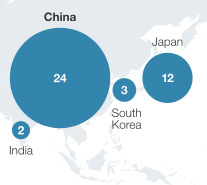Apr 26 2017
New Chart Junk: Squaring The Pie
The purpose of graphics for data visualization is communication, not decoration, which is often forgotten in publications as well as on company performance dashboards. A case in point is the chart on yesterday’s cover of the New York Times. It shows that solar energy currently accounts for more than twice as many jobs as coal. It also shows the numbers of jobs in different sectors and uses a color code to mark some as based on fossil fuels versus renewable and low-emission technologies.

Until recently, most publications would have used a pie chart. Now, graphic artists have found a way to square the pie chart into yet another style that will most likely trickle down to slideware and office walls, in spite of a low data-to-ink ratio and the use of two-dimensional shapes to display one-dimensional data.



Aug 24 2017
Sophisticated Graphics In The New York Times
“Even after decades of affirmative action, black and Hispanic students are more underrepresented at the nation’s top colleges and universities than they were 35 years ago, according to a New York Times analysis. The share of black freshmen at elite schools is virtually unchanged since 1980. Black students are just 6 percent of freshmen but 15 percent of college-age Americans, as the chart below shows.”
Sourced through the New York Times
Michel Baudin‘s comments: This morning’s New York Times contains an article with data visualizations at varying levels of detail that are far more sophisticated than the usual pie charts and stacked bar charts commonly found in the American press as well as in business presentations and shop floor performance dashboards.
The exact meaning of the above chart between the title and the lead of the article is not immediately obvious. After looking at it for a minute or two, you realize that it has a high data-to-ink ratio: it makes a non-trivial point in a flourish-free format that I think Edward Tufte would approve.
The article is about the relative representation of different groups in the student population of 101 institutions, including the Ivy League, University of California campuses, “top liberal arts colleges,” “other top universities,” and “public flagship universities.” The study compares the proportion of freshmen enrolled from each group to their proportion in the college-age population as a whole.
Share this:
Like this:
By Michel Baudin • Press clippings 0 • Tags: Chart Junk, Data visualization, Data-to-ink ratio